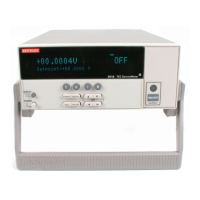3-12 Basic Operation Models 2510 and 2510-AT User’s Manual
Step 3: Configure selected function.
Send the commands to program temperature units, protection limits, sensor type, sensor
parameters, and PID loop constants. For example, the following commands configure the
temperature function:
:UNIT:TEMP CEL Celsius temperature limits
:SOUR:TEMP:PROT 100 Upper temperature limit = 100˚
:SOUR:TEMP:PROT:LOW 10 Lower temperature limit = 10˚
:TEMP:TRAN RTD Select RTD temperature sensor
:TEMP:RTD:TYPE PT100 Select PT100 RTD sensor
:TEMP:RTD:RANG 100 Set 100Ω range.
:TEMP:CURR:AUTO ON Use default RTD sensor current
:SYST:RSEN ON Enable 4-wire sensing
:SOUR:TEMP:LCON 10 Temperature gain constant = 10
:SOUR:TEMP:LCON:INT 0.5 Temperature integral constant = 0.5
:SOUR:TEMP:LCON:DER 0 Temperature derivative constant = 0
Step 4: Program setpoint.
Program the setpoint for the selected control function. For example, the following com-
mand programs the temperature setpoint to 50˚:
:SOUR:TEMP 50
Step 5: Set current limit.
If required, set the current limit with this command:
:SENS:CURR:PROT<Current_Limit>
Step 6: Turn output on.
Turn the output on to begin PID control by sending the following commands:
:OUTP ON
Step 7: Request readings.
During operation, you can request readings with the :FETCH? query. Note that bus read-
ing elements are controlled with the :FORM:ELEM command. You can also request addi-
tional reading types with the following queries:
:MEAS:POW? Query thermoelectric cooler power
:MEAS:CURR? Query cooler current
:MEAS:TEMP? Query temperature
:MEAS:RES? Query cooler DC resistance
:MEAS:VOLT? Query cooler voltage

